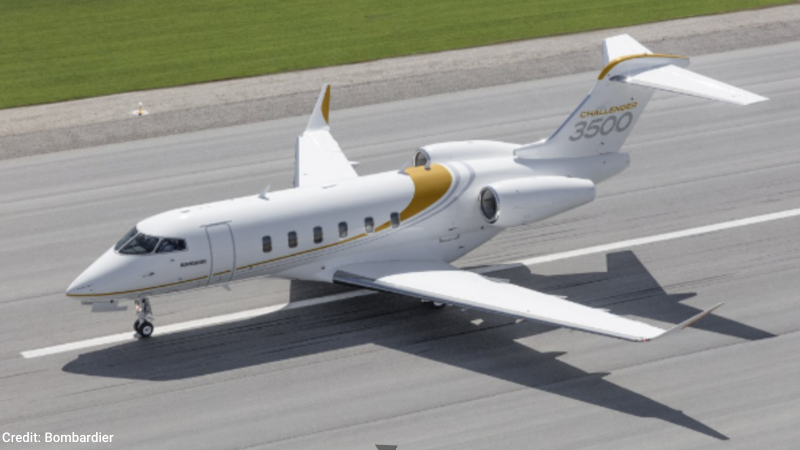Aircraft Overview: Bombardier Challenger 300 / 350 / 3500
Aircraft Overview: Bombardier Challenger 300 / 350 / 3500

Bombardier Challenger 300 / 350/ 3500
Bombardier’s Challenger 300, 350 and 3500 are super-midsize business jets that represent the three commercial designations of the Canadian manufacturer’s BD-100-1A10 type.
That type initially received Transport Canada certification on May 30, 2003, while the first updated version—the Challenger 350—was announced on May 20, 2013, and subsequently received “full type certification” from Transport Canada on June 11, 2014.
Bombardier announced another upgraded version of the BD-100-1A10 on Sept. 14, 2021, the Challenger 3500, with that airframe featuring a cabin that is “fully redesigned.” The airframe manufacturer announced the entry-into-service of the Challenger 3500 on Sept. 20, 2022.
Cabin
The maximum passenger capacity of the BD-100-1A10 is 16, with two pilots also being required. Challenger 350 and 3500 passengers are accommodated in a cabin has a height of 6 ft., width of 7 ft. 2 in. and length of 25 ft. 2 in., the latter of which is measured between the “cockpit divider [and the] aft most cabin without [the] baggage compartment.”
Despite being certified to accommodate that number of passengers, Bombardier markets the Challenger 3500’s cabin as offering “flexible seating arrangements for” as many as 10 passengers, with the Challenger 350 and 3500 both having a 106-ft.3 baggage compartment.
In comparison to the Challenger 350, the cabin altitude of the Challenger 3500 was reduced by 31% to 4,850 ft. when flying at 41,000 ft.
Avionics
Pilots operate all three commercial designations by utilizing the same avionics system, Collins Aerospace’s Pro Line 21 integrated avionics system.
The Challenger 350 and the in-production Challenger 3500 feature the Pro Line 21 Advanced avionics suite which includes “four large displays,” as well as dual flight management systems (FMS) that allow the airplane to perform localizer performance with vertical guidance (LPV) and required navigation performance (RNP) approaches.
Furthermore, those airframes have dual GPS and inertial reference systems (IRS)—the former of which enables the utilization of satellite-based augmentation systems (SBAS) such as the wide area augmentation system (WAAS)—as well as MultiScan weather radar and a synthetic vision system (SVS).
A head-up display (HUD) “with enhanced vision system (EVS)” was available for the Challenger 350 and remains so for the Challenger 3500, with the latter airframe introducing an autothrottle system which is standard.
Unlock the data behind the charts with Aviation Week Intelligence Network’s Fleet & Data Services. Learn more at aviationweek.com/bcaaircraftoverview.
For a comprehensive Program Profile including recent articles, program suppliers and current operators, please access via AWIN subscription here.
Variants
The pair of HTF7000 engines (AS907-1-1A) that power the Challenger 300 can produce 6,826 lb. of thrust, while the Challenger 350 and 3500’s HTF7350 engines (AS907-2-1A) increase the amount of thrust to 7,323 lb.
Similarly, the maximum takeoff weight (MTOW) of the former version of the BD-100-1A10 is 38,850 lb., a limitation that the Challenger 350 and 3500 increase to 40,600 lb.
Beyond that weight limitation, Bombardier states that the Challenger 350 and 3500 have a 24,800-lb. basic operating weight, 3,400-lb. maximum payload and 14,150-lb. maximum fuel weight.
Mission and Performance
Regardless of the commercial designation, the operating limitations of the BD-100-1A10 include a maximum operating limit Mach (MMO) of 0.83 Mach above 29,475 ft.
The type is also limited to a maximum operating altitude of 45,000 ft. while en route, as well as a 10,000-ft. limitation for takeoff and landing.
In addition to those altitude limitations, the initial cruise altitude for the Challenger 350 and 3500 at the airframe’s MTOW is 43,000 ft.
According to Bombardier, the Challenger 350 and 3500 are capable of a takeoff distance—based on the MTOW, sea-level altitude and International Standard Atmosphere (ISA) conditions—of 4,835 ft.
At a typical landing weight, as well as at sea-level altitude and in ISA conditions, those versions of the airplane have a landing distance of 2,364 ft. When carrying eight passengers and flying at a 0.80 Mach cruise speed, the Challenger 300 was marketed as capable of a 3,065-nm range.
Comparatively, the 3,200-nm theoretical maximum range of the Challenger 350 assumed an airplane that was carrying eight passengers and two crew, National Business Aviation Association (NBAA) instrument flight rules (IFR) reserves and ISA conditions.
With a takeoff temperature of ISA +15C; carrying four passengers, two crew and NBAA IFR reserves; and operated at 0.77 Mach, the Challenger 3500 increases the theoretical maximum range to 3,400 nm.
Bombardier Challenger 350/3500 Images
Aviation Week Network is home to market-leading data and intelligence products. Find out which database is best for your business.
www.aircharterguide.com/
www.aircraftbluebook.com
www.acukwik.com/Products
www.airportdata.com
www.fleet.aviationweek.com